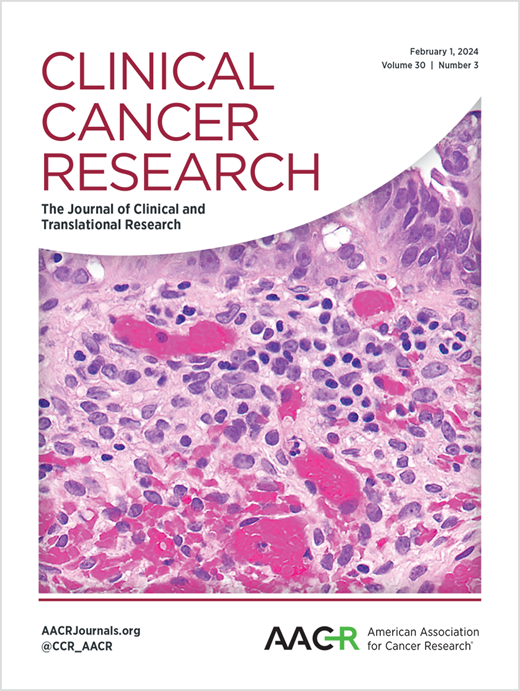Immune-MRD status informs tumor-MRD outcome prognostication in patients with multiple myeloma on lenalidomide maintenance
IF 10.2
1区 医学
Q1 ONCOLOGY
引用次数: 0
Abstract
Purpose: Lenalidomide maintenance is the most frequently utilized approach for newly diagnosed multiple myeloma (MM) patients following induction therapy with/without consolidative high-dose melphalan and autologous stem cell transplantation. Baseline and longitudinal measurable residual disease (MRD) negative status is a well-established positive predictive sign in lenalidomide maintenance patients. However, the clinical utility of serial MRD assessments remains uncertain, as there is no consensus on the clinical management of MRD-resurgence (MRDres) or stable remissions in patients positive for MRD. Experimental Design: Here we report the complete and final results of a phase 2, single-arm study of 5 years of continuous lenalidomide maintenance in MM patients following unrestricted upfront therapy, along with exploratory peripheral blood T cell profiling experiments performed via high-dimensional spectral cytometry. Results: Patients with MRDres had inferior PFS to those with sustained MRD-negativity at the 1- and 2-year landmarks (P=0.036, P=0.0014 respectively); however, myeloma progression only occurred within 2 years of MRDres in 36% of patients, with no progression observed in the remaining 64% of patients at last follow-up. Exploratory peripheral blood T cell profiling experiments throughout the trial period identified an immune signature of early relapse in patient cohorts both negative and positive for MRD at the start of maintenance therapy. T cell profiles enriched with activated cytotoxic effectors predicted early relapse while quiescent T cell profiles enriched with naïve T cell populations predicted durable remissions. Conclusions: This “immune-MRD” status showed predictive potential, and segregated patients with MRDres and early disease progression from patients with sustained remission despite MRDres.来那度胺维持治疗的多发性骨髓瘤患者的免疫mrd状态提示肿瘤mrd预后
目的:来那度胺维持是新诊断的多发性骨髓瘤(MM)患者在合并/不合并大剂量美法兰和自体干细胞移植诱导治疗后最常用的方法。基线和纵向可测量残留病(MRD)阴性状态是来那度胺维持患者的一个公认的阳性预测信号。然而,系列MRD评估的临床应用仍然不确定,因为对于MRD阳性患者的MRD复发(MRDres)或稳定缓解的临床管理尚无共识。实验设计:在此,我们报告了一项2期单臂研究的完整和最终结果,该研究对MM患者进行了不受限制的前期治疗,持续维持来那度胺5年,并通过高维光谱细胞术进行了探索性外周血T细胞分析实验。结果:MRDres患者在1年和2年里程碑时的PFS低于持续mrd阴性患者(P=0.036, P=0.0014);然而,36%的患者仅在MRDres后2年内出现骨髓瘤进展,其余64%的患者在最后随访时未观察到进展。在整个试验期间,探索性外周血T细胞分析实验确定了在维持治疗开始时MRD阴性和阳性患者队列中早期复发的免疫特征。富含活化细胞毒性效应物的T细胞谱预测早期复发,而富含naïve T细胞群的静止T细胞谱预测持久缓解。结论:这种“免疫- mrd”状态具有预测潜力,并将MRDres和早期疾病进展的患者与MRDres持续缓解的患者分开。
本文章由计算机程序翻译,如有差异,请以英文原文为准。
求助全文
约1分钟内获得全文
求助全文
来源期刊

Clinical Cancer Research
医学-肿瘤学
CiteScore
20.10
自引率
1.70%
发文量
1207
审稿时长
2.1 months
期刊介绍:
Clinical Cancer Research is a journal focusing on groundbreaking research in cancer, specifically in the areas where the laboratory and the clinic intersect. Our primary interest lies in clinical trials that investigate novel treatments, accompanied by research on pharmacology, molecular alterations, and biomarkers that can predict response or resistance to these treatments. Furthermore, we prioritize laboratory and animal studies that explore new drugs and targeted agents with the potential to advance to clinical trials. We also encourage research on targetable mechanisms of cancer development, progression, and metastasis.
 求助内容:
求助内容: 应助结果提醒方式:
应助结果提醒方式:


